Read this Jaisalmer travel guide to find out the Golden City’s 8 amazing points of interest.
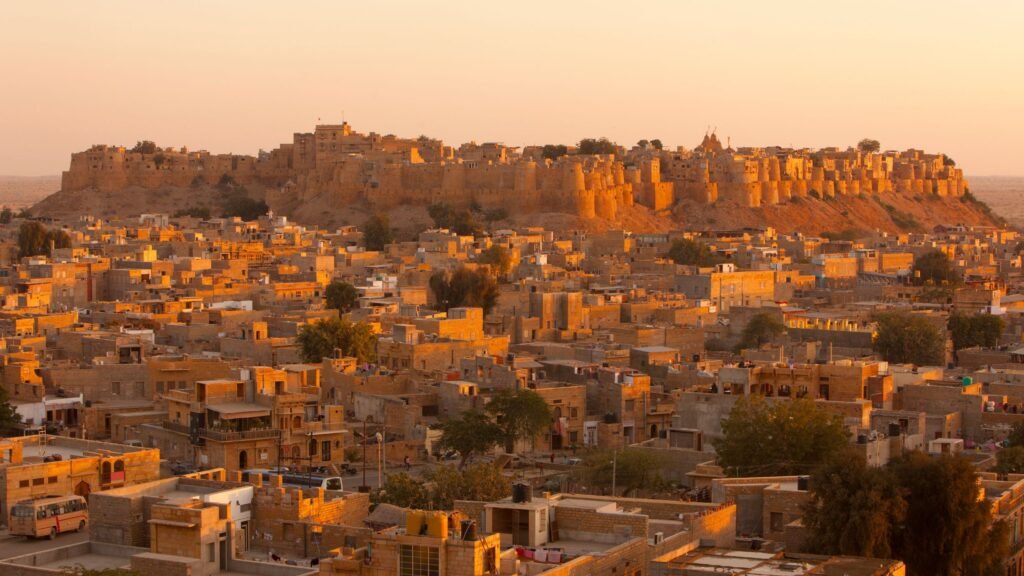
“Padharo Mhare Desh” – In the heart of Thar, like a magical desert mirage, exists Jaisalmer (Hill Fort of Jaisal) – a city that seems like as if must have risen above, from the shrouds of ‘golden’ desert sand which hem in. Therefore, often termed as the ‘golden city’, it is hard to escape the golden-yellow hues that paint the cityscape in its entirety. Historically, all constructions were made out of yellow sandstone as it was geographically the only available material; more so to keep up with the ancient charms, new buildings are also constructed with the same, to enhance the allure of this extraordinary desert city.
Owing to its strategic location very close to the India-Pakistan border, it also acts as a base for the Indian army and airforce.
Jaisalmer is a must for every travel buff, for it is nothing short of a miracle to have survived the tides of time since many centuries and still going strong without allowing the desert sands to blind its vibrant past.
- How to reach: Easily by road, rail, or air routes from other major cities like Jaipur, Jodhpur, and Delhi.
- Best time to visit: Only half a year, which is basically the cooler winter months between October and March, for the desert city burns hot like a furnace during the remaining months.
Jaisalmer points of interest tourists must visit
Here are the choicest ‘points of interest’ to pay a visit to in Jaisalmer for the best impressions of the place:
1. Sonar Quila
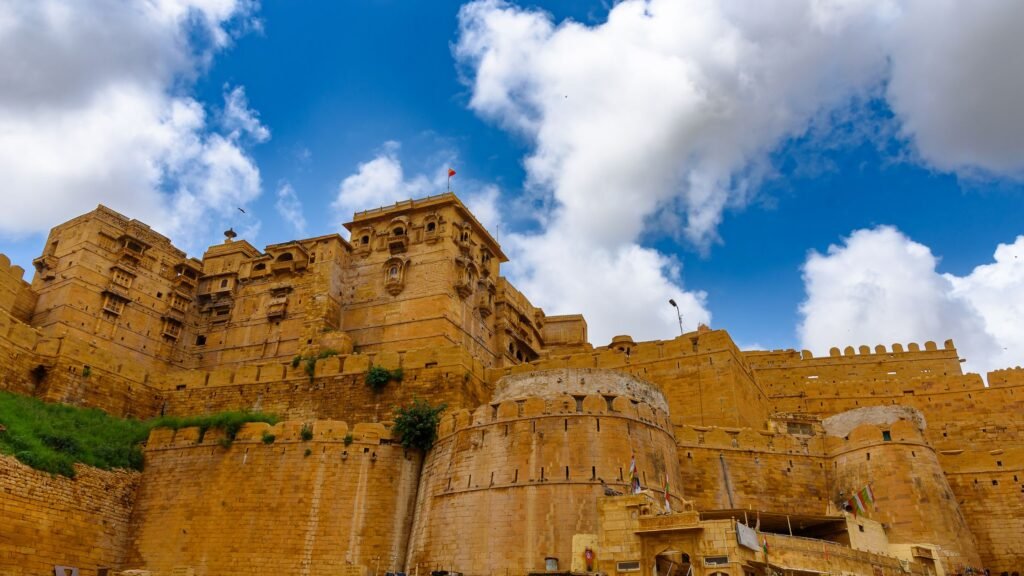
The ‘Golden Fortress’ or the Jaisalmer Fort, a UNESCO World Heritage Site is an absolute stunner. Looking like a sand castle from afar, it is one of the few ‘living’ forts in the world and the second oldest fort in Rajasthan constructed with yellow sandstone by the Rajput ruler Maharawal Jaisal Singh of the Bhati clan in 1156 CE. In actual fact, until the 17th century, the fort held the entire city’s population within its ramparts, and it was only afterward that the city grew beyond its walls. Even now about 4000 people still remain within the fort.
The goldenish-amber colored fort with 4 main entrances [Ganesh Pol, Suraj Pol, Akshya Pol, Hawa Pol] is raised at a 250 ft high altitude on a hill. At 1500 ft long, 750 ft wide, and with 30 ft high walls and 99 bastions, the fort is a glorious one with an awe-inspiring map. Intersecting pathways inside the fort lead into palaces, temples, and houses, out of which the Maharawal Palace and Jain temple are quite notable for their amazing sculpt-work.
Repeated capture and re-capture of the fort from enemies and subsequent surrender to the British rule, led to the inevitable downfall of the kingdom and the thriving trade center that it once used to be, as a part of the Silk Route. Today the fort city is majorly surviving on tourism.
The Fort is among the top places to shop for local crafts, jewelry, textiles, and souvenirs from its umpteen numbers of stalls.
2. Longewala War Museum
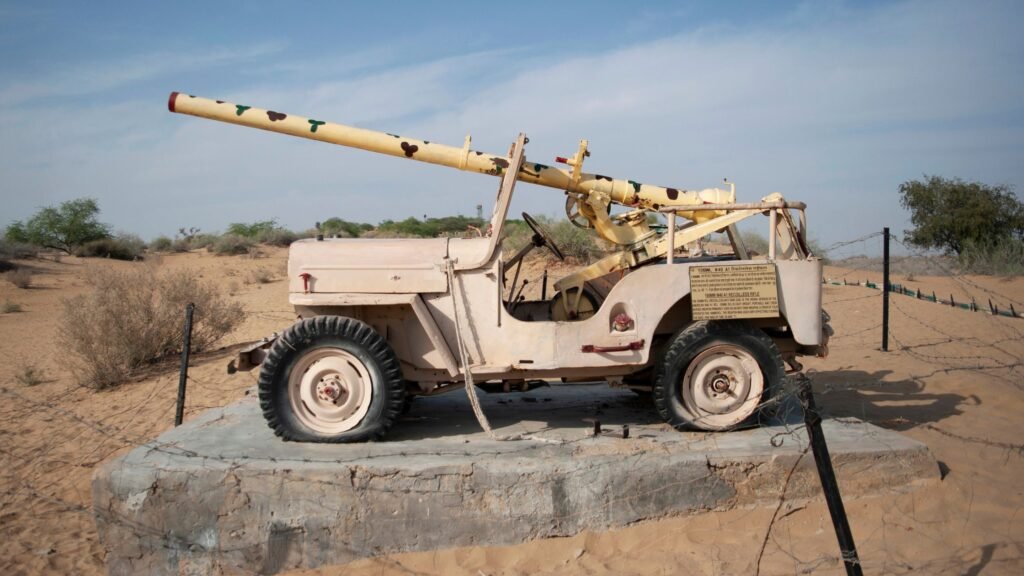
This is a war memorial built exactly at the spot where the ‘Battle of Longewala of 1971’ between India and Pakistan took place. Longewala is a border town situated in the Thar desert, in the westernmost part of Jaisalmer.
Maintained by the Indian army, this place recounts one of the toughest battles fought by our valorous armed forces. The spotlights of the museum are the huge army tanks (of both of India and Pakistan) stationed on the campus.
3. Tanot Mata Temple

A long desert road leads into the village of Tanot, about 10 km from the border to Pakistan {around 38 km further from Longewala war museum}, where the temple of ‘Tanot Mata’ who is believed to be the incarnation of goddess ‘Hinglaj Mata’ (Goddess of War) is especially revered by the Indian armed forces. People are generally not allowed beyond this temple point to visit the border unless they have secured ‘permission’ from the military authorities.
Although the temple has been standing where it is, since the 9th century CE, it was only during the battle of 1965 with Pakistan that it became famous among the Indian soldiers as the ‘miracle’ temple. The story goes that Tanot Mata saved the Indian battalion from a sudden attack by Pakistan who hurled nearly 3000 bombs at them who were near the temple premise; whence each of those bombs either miraculously disappeared or did not at all explode as expected.
4. Patwon ki Haveli

This one is probably the most brilliant architectural masterpiece to find in Jaisalmer. Yet another structure made out of the city’s trademark yellow sandstone, the haveli or mansion is so magnificently built in its details that it gleams ‘golden’ under the desert sun. The rich honey colour of the building and the finesse of its carvings on the façade render it a ‘bejewelled‘look, making it a timeless example of Rajasthani and Persian fusion art.
It was built in the early 1800s over a span of 50 years by Jaisalmer’s wealthiest merchant named Guman Chand Patwa, who attained fame for his trade in gems and brocades. He made the mansion for his five sons and hence the haveli which speaks of the unbelievable ‘luxury’ of the 19th century in its truest sense and that too in a ‘desert’, totally comprised of five grand houses.
Located in the Patwa valley, walking inside the mansion could leave the visitors in a bit of a daze as they navigate through the maze of multiple storeys, but usually come out of the haveli feeling happy and hypnotized by the innumerable lattice (jali) works, mirror works, stonework, artefacts, motifs, murals, and opulent rooms. Although the five houses appear to be clustered on a narrow alley, they have over 60 balconies (jharokhas) which open out to a spacious vista.
The ground floor now houses stalls permitted by the government to sell colorful Rajasthani handlooms. All the more, the terrace offers an incredible roof-top view of the ‘monumentous’ Jaisalmer Fort which is at a stone’s throw away from the Haveli.
Patwon ki Haveli is like a museum that treasures the centuries-old memorabilia and antiquities of the Patwa family.
5. Sam Sand Dunes
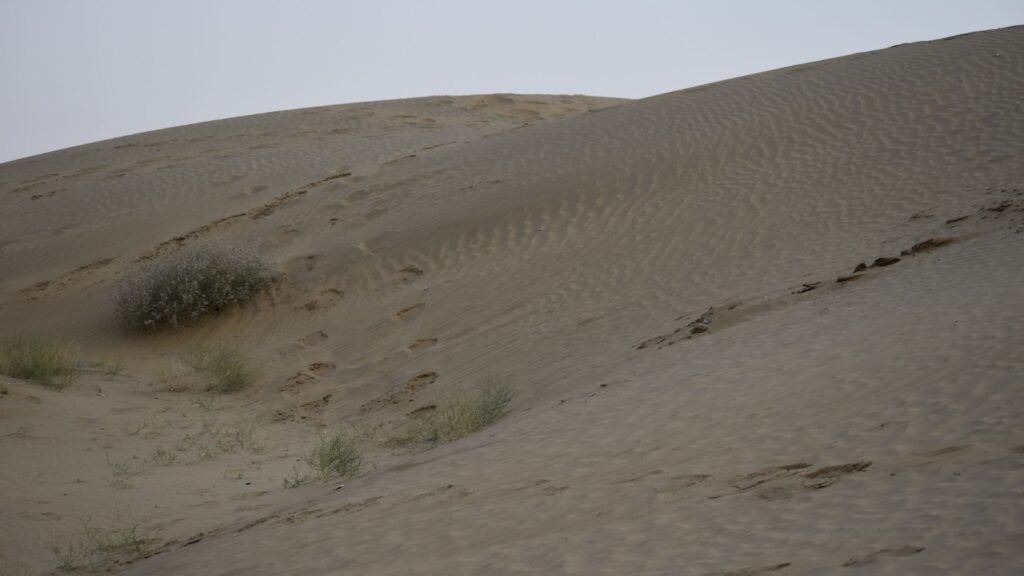
A pleasant excursion in the midst of endless sandy and wavy dunes is what Jaisalmer truly stands out for! 20 – 40 km from the main city, the Sam Sand Dunes in the Thar desert of western Rajasthan offer excellent camping facilities which every person would dream of! These camps not only offer luxury tent stays but include other programs as well, as a part of their entertainment packages like cultural music and dance shows, dinners around light bonfires, jolly camel safaris, daring dune bashings in jeep safaris, and uproarious desert quad biking.
6. Gadisar Lake
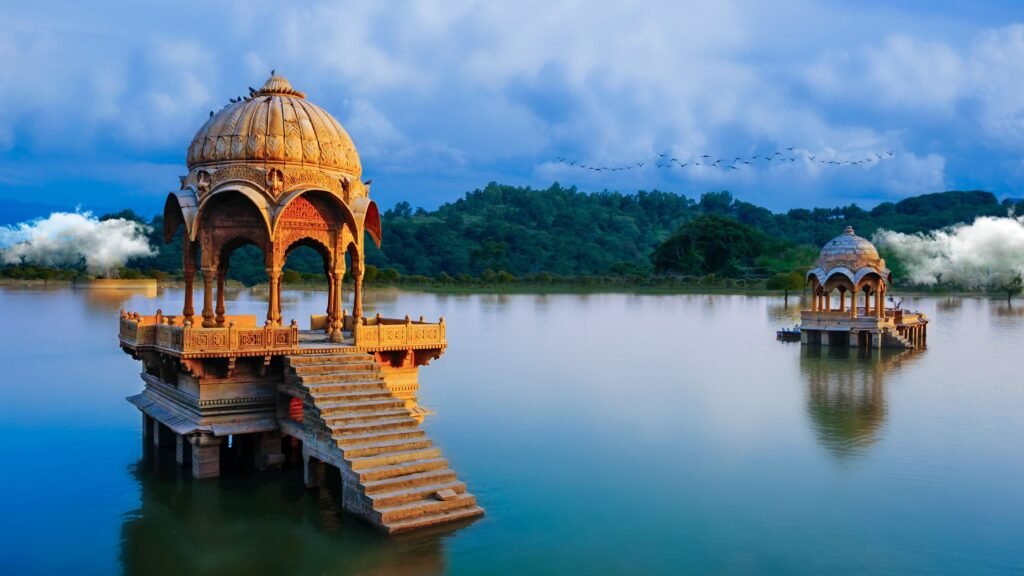
Just like an oasis in a desert, Gadisar Lake is a welcome respite in the golden city, which is otherwise a parched desert city. The manmade lake was built in the 12th century to serve as a water conservation tank by the then Maharaja of Jaisalmer, Maharawal Gadsi Singh. Now it is flocked for being a much-required escapade from the blazing heat. It is a point of relaxation where people spend time leisurely, drawing up the cool breeze, boating in the reservoir, and witnessing sunsets/sunrises that reflect beautifully in the waters.
The lake is ensured of never seeing a dry spell as it is supplied with water throughout the year with the help of Indra Gandhi Canal, India’s longest canal bringing water from the Beas & Sutlej, all the way from Punjab into the Thar desert.
Famous for its panoramic view, an archway called ‘Tilon ki Pol’ marks the entry to this lake that has been uplifted with other grand structures along the banks including temples, watch towers at various points in the lake at a medium height which are designed like chhatris with a flight of stairs, and a cultural museum.
A most recent and unmissable addition at the Gadisar Lake would be the Laser Water Show which has water screen projections, during late evenings to depict stories like the founding of Jaisalmer city, and glimpses of other important landmarks.
7. Kuldhara
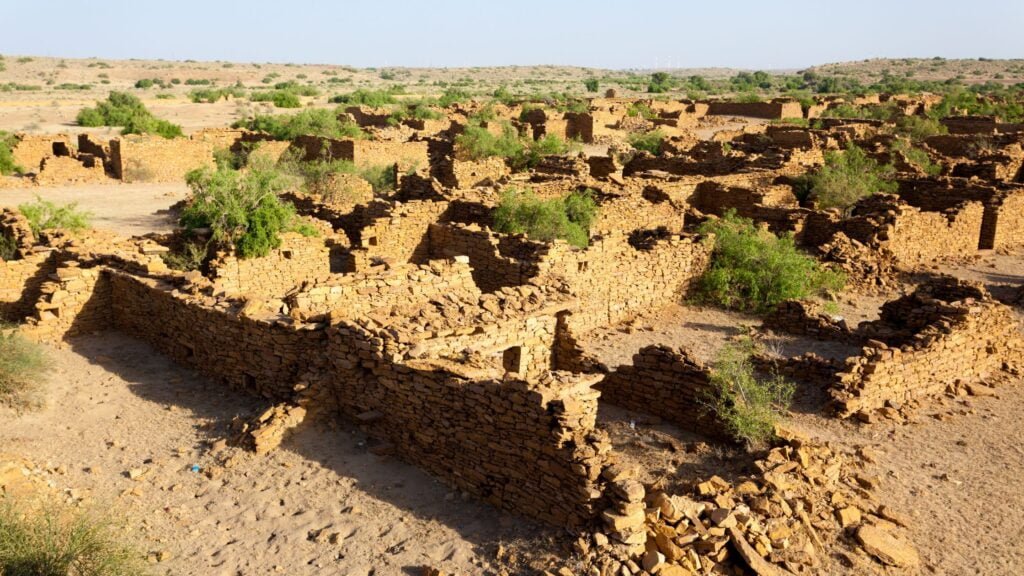
Counted as one of the haunted villages of Rajasthan, but not to worry as it is only an abandoned village, Kuldhara lies 18 km southwest of Jaisalmer. It is said that it once stood as the prosperous dwelling of the rich Paliwal Brahmin community (13th century to 19th century), but some unforeseen circumstances like severe drought and atrocious behavior committed upon them by the local minister Salim Singh, forced the entire troupe to leave the village overnight. No one’s got a clue as to where so many of them may have disappeared, but what can be seen today nearly 2000 years after the unfortunate incident are hundreds and hundreds of houses just left in ruins.
Based on some research, some of the houses have been reshaped for tourist purposes, to give an idea of how it may have looked earlier, but other than that, there is nothing else to be seen beyond the ruins for many a mile in the ‘desert’ed region.
8. Vyas Chattri

A wonderful 18th-century memorial constructed by Maharawal Jawahar Singh, reflecting the majestic Rajasthani architecture was built in memory of Sage Vyas. It comprises of a series of cenotaphs (grandly carved ‘chhattris’ {umbrella-like arches} placed on pillars) – each to symbolically represent the descendant members of the Brahmin community. Being located on a hill, the Jaisalmer Fort is visible from here.
ALSO READ: Jodhpur – Lost in the Blue Bylanes
